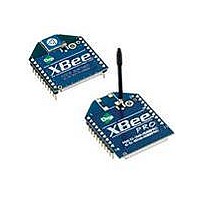XBP09-DPSIT-156 Digi International, XBP09-DPSIT-156 Datasheet - Page 20

XBP09-DPSIT-156
Manufacturer Part Number
XBP09-DPSIT-156
Description
MODULE XBEE PRO W/RPSMA
Manufacturer
Digi International
Series
XBEE-PRO™r
Specifications of XBP09-DPSIT-156
Frequency
902MHz ~ 928MHz
Data Rate - Maximum
156kbps
Modulation Or Protocol
FHSS
Applications
ISM
Power - Output
17dBm (50mW)
Sensitivity
-100dBm
Voltage - Supply
3 V ~ 3.6 V
Current - Receiving
80mA
Current - Transmitting
210mA
Data Interface
PCB, Through Hole
Antenna Connector
RP-SMA
Operating Temperature
-40°C ~ 85°C
Package / Case
Module
Lead Free Status / RoHS Status
Lead free / RoHS Compliant
Memory Size
-
Lead Free Status / Rohs Status
Lead free / RoHS Compliant
Other names
602-1169
XBee‐PRO® 900 RF Modules
Commissioning Pushbutton
Associate LED
The commissioning pushbutton definitions provide a variety of simple functions to aid in deploying
devices in a network. The commissioning button functionality on pin 20 is enabled by setting the
D0 command to 1 (enabled by default).
Button presses may be simulated in software using the ATCB command. ATCB should be issued
with a parameter set to the number of button presses to execute. (i.e. sending ATCB1 will execute
the action(s) associated with a single button press.)
The node identification frame is similar to the node discovery response frame – it contains the
device’s address, node identifier string (NI command), and other relevant data. All API devices
that receive the node identification frame send it out their UART as an API Node Identification
Indicator frame (0x95).
The Associate pin (pin 15) can provide indication of the device's sleep status and diagnostic
information. To take advantage of these indications, an LED can be connected to the Associate pin
as shown in the figure above. The Associate LED functionality is enabled by setting the D5
command to 1 (enabled by default). If enabled, the Associate pin is configured as an output and
will behave as described in the following sections.
The Associate pin indicates the synchronization status of a sleep compatible node. On a non-sleep
compatible node the pin functions has a power indicator. The following table describes this
functionality:
The LT command can be used to override the blink rate of the Associate pin. When set to 0, the
device uses the default blink time (500ms for sleep coordinator, 250ms otherwise).
Button Presses
1
1
2
2
4
No
Yes
© 2009 Digi International, Inc.
compatible?
Sleep
Not configured for sleep
Configured for sleep
Not configured for sleep
Configured for sleep
Either
On, blinking green
On, solid green
Configuration and
Sync Status
LED Status
Sleep
Immediately sends a Node Identification
broadcast transmission.
All devices that receive this transmission will
blink their Associate LED rapidly for 1 second.
All API devices that receive this transmission
will send a Node Identification frame out their
UART (API ID 0x95)
Wakes the module for 30 seconds (or until the
entire network goes to sleep). Queues a Node
Identification broadcast transmission to be sent
at the beginning of the next network wake cycle.
All devices that receive this transmission will
blink their Associate LED rapidly for 1 second.
All API devices that receive this transmission
will send a Node Identification frame out their
UART (API ID 0x95).
Not supported.
Causes a node which is configured with
sleeping router nomination enabled (see
description of the ATSO – sleep options
command in the XBee module’s Product
Manual) to immediately nominate itself as the
network sleep coordinator.
Issues an ATRE to restore module parameters
to default values.
The device is powered and operating properly.
The device has not synchronized with the
network or has lost synchronization with the
network.
Meaning
Action
20














